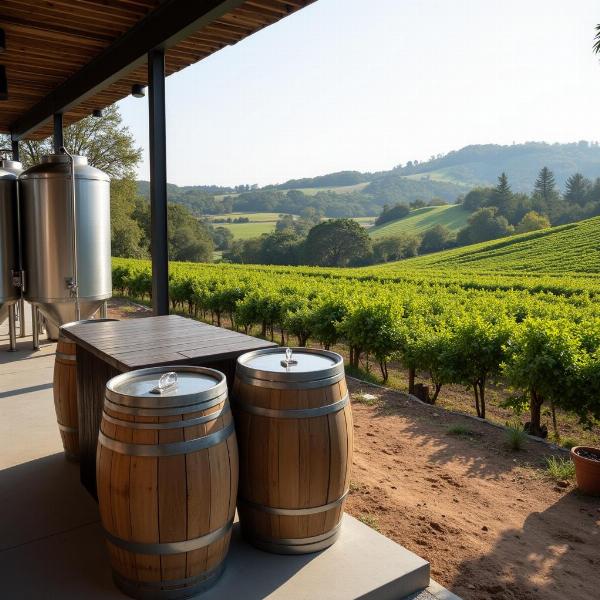Viticulture, the art and science of grape cultivation, finds its Hindi equivalent in “अंगूर की खेती” (angur ki kheti), literally translating to “grape farming.” While this simple translation captures the essence of viticulture meaning in hindi, it doesn’t fully encompass the depth and breadth of this ancient practice deeply intertwined with India’s agricultural landscape and burgeoning wine industry. This guide delves into the nuances of viticulture in India, exploring its history, techniques, and cultural significance.
Understanding Viticulture in the Indian Context
Viticulture in India has a rich history, though its association with wine production is relatively recent. Traditionally, grapes were cultivated primarily for table consumption, raisin production, and juice extraction. However, the burgeoning interest in wine has led to a significant shift, with increasing emphasis on viticulture practices aimed at producing high-quality wine grapes. This necessitates a deeper understanding of viticulture meaning in hindi, extending beyond the basic translation to encompass the specific techniques and considerations relevant to Indian terroir and climate.
The diverse climatic conditions across India present both opportunities and challenges for viticulturalists. From the temperate hills of Himachal Pradesh to the warm plains of Maharashtra, various grape varieties thrive in different regions, each contributing to the unique character of Indian wines. This geographical diversity adds another layer to viticulture meaning in hindi, emphasizing the region-specific approaches and adaptations necessary for successful grape cultivation.
Key Aspects of Viticulture Meaning in Hindi
Understanding viticulture meaning in hindi requires exploring its various facets. This encompasses everything from vineyard establishment and grapevine management to pest and disease control, harvesting, and post-harvest practices. Each step plays a crucial role in determining the quality and yield of the grapes, ultimately influencing the final product, whether it be table grapes, raisins, juice, or wine.
Vineyard Site Selection and Preparation
Choosing the right location for a vineyard is paramount. Factors such as soil type, drainage, sunlight exposure, and slope play a critical role in grapevine health and productivity. Proper soil preparation is also crucial, involving activities like tilling, fertilization, and amending the soil to create an optimal growing environment.
Grapevine Training and Pruning
Training and pruning grapevines are essential for managing their growth and ensuring optimal fruit production. Different training systems are employed depending on the grape variety and the desired canopy shape. Pruning helps regulate the vine’s size, removes dead or diseased wood, and promotes the development of fruit-bearing shoots.
Pest and Disease Management
Protecting grapevines from pests and diseases is a continuous challenge for viticulturalists. Implementing integrated pest management strategies, including biological control, cultural practices, and judicious use of pesticides, is essential for maintaining vine health and ensuring a high-quality harvest.
Viticulture and the Indian Wine Industry
The growing popularity of wine in India has significantly impacted the practice of viticulture. Wine grapes require specific viticultural practices that differ from those used for table grapes or raisin production. This has led to increased adoption of modern viticultural techniques and technologies, focusing on optimizing grape quality for winemaking.
 Indian Wine Industry and Viticulture
Indian Wine Industry and Viticulture
What are the common grape varieties grown in India for wine production?
Some popular varieties include Sauvignon Blanc, Cabernet Sauvignon, Shiraz, and Chenin Blanc. Indian viticulturalists are also exploring indigenous grape varieties with the potential for producing unique and expressive wines.
How does the Indian climate affect viticulture practices?
The warm climate necessitates specific vineyard management techniques, such as providing shade and ensuring adequate water supply during dry periods. The monsoon season also presents challenges, requiring careful management of diseases and pests.
Conclusion
Viticulture meaning in hindi encompasses a multifaceted understanding of grape cultivation, ranging from traditional practices to modern techniques tailored to the Indian context. As the Indian wine industry continues to evolve, so too will the understanding and application of viticulture, contributing to the growth and diversification of this ancient agricultural practice.
FAQ
- What is the literal translation of viticulture in Hindi? The literal translation is “अंगूर की खेती” (angur ki kheti), meaning grape farming.
- What are the main uses of grapes in India? Grapes are used for table consumption, raisin production, juice extraction, and increasingly, winemaking.
- What are some challenges faced by Indian viticulturalists? Challenges include diverse climatic conditions, pest and disease management, and adapting to the specific needs of wine grape cultivation.
- Is the Indian wine industry growing? Yes, the Indian wine industry is experiencing significant growth, leading to increased focus on quality viticulture practices.
- Where can I learn more about viticulture in India? Various agricultural universities and research institutions offer resources and information on viticulture in India.
Meaning-Hindi.in offers expert translation services in Hindi and other languages, specializing in various domains, including business, legal, technical, website localization, and educational materials. Our team of experienced translators ensures accurate and culturally sensitive translations, tailored to your specific needs. Contact us at [email protected] or +91 11-4502-7584 for high-quality translation solutions. Meaning-Hindi.in is your trusted partner for all your language needs.